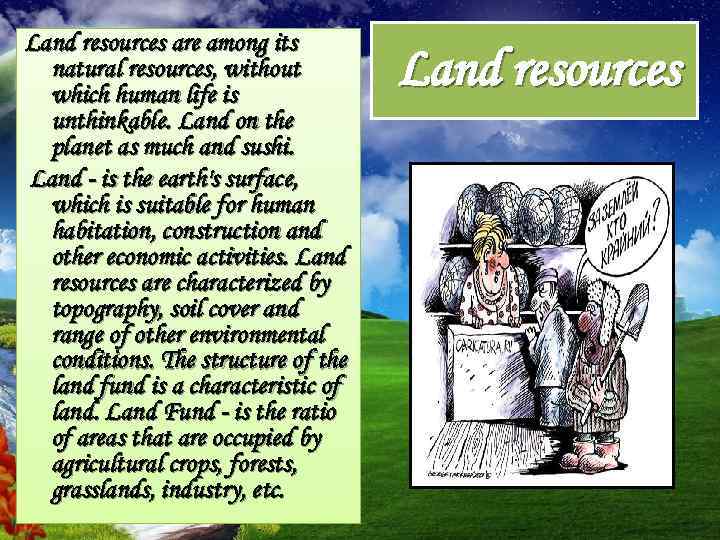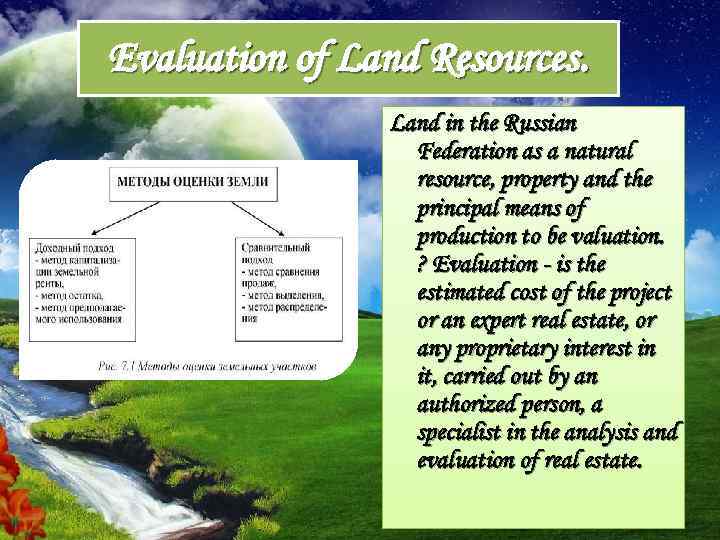Распределение - копия.pptx
- Количество слайдов: 21

Distribution. The use and evaluation of land resources.

Land resources are among its natural resources, without which human life is unthinkable. Land on the planet as much and sushi. Land - is the earth's surface, which is suitable for human habitation, construction and other economic activities. Land resources are characterized by topography, soil cover and range of other environmental conditions. The structure of the land fund is a characteristic of land. Land Fund - is the ratio of areas that are occupied by agricultural crops, forests, grasslands, industry, etc. Land resources

Land soil cover of the Earth were created thousands of years - is the foundation of wildlife and agricultural production. One-third of the land fund of the planet - is farmland, i. e, the land used for food production. About 3/4 of all the planet's soil resources have reduced productivity due to insufficient supply of heat and moisture. Agricultural land - is arable land, perennial plants, natural meadows and pastures. Land Fund consists of unproductive lands (deserts, high mountains). Structure Land use: arable land - 11%, pastures and meadows - from 23 to 25%, forests and shrubs - 31%, settlements - 2%, and the rest of the territory occupied by low-productive and unproductive land (mountains, swamps, glaciers, deserts). Cultivated lands account for about 88% needed for human food. Mankind has been fighting for the expansion of lands that are suitable for agriculture and habitation. Land development deal with Russia, the U. S. , China, Kazakhstan, Canada and Brazil.

Saving land resources of the planet - this is one of the major problems of mankind. Land resources are reduced, since the productive land were allocated for the development of mining and construction, destroyed cities and other populated areas, flooded during the construction of reservoirs, etc. The problem of agriculture - is soil degradation due to improper land use. Soil erosion reduces their fertility, damage crops. Inconvenient land in agricultural areas are due to potholes, gullies and ravines. In connection with the process of erosion of the global agricultural circulation drop 6. 7 million hectares of land, but due to salinity, water logging - another 1. 5 million hectares. Gradually depleted upper fertile layer. The process of desertification - an extension of deserts, their attack on the agricultural land. This process is typical for many regions of the world.

Land distribution by category and by land. By land area refers to the determination of the land surface with a variety of landscapes, soils, climate and a number of other properties. ? Total land fund of the Russian Federation is about 1710 million hectares, with an average population density of about 86 people. / Th. ha. (8. 6 persons/km 2) and land development.

The territory of the Russian Federation have peculiarities and especially express heterogeneity of climatic and litho logical and geomorphologic conditions and geological history that determines the diversity of soil cover. ? Of comparing the quality of land resources for their suitability for different types of land use requires the development of a uniform system of classification.

Isolated as a rule, the following categories of land: 1. Lands of agricultural enterprises, organizations and citizens, i. e. areas used primarily for agricultural purposes. 2. Land administered by the city, town and village administrations - areas that are within the character (the border) settlements and land transferred to the Authority. ? 3. Industrial, transport and other facilities - the territory granted to the enterprises, various associations and organizations for their assigned special tasks (manufacturing, transportation, communications, etc. ).

4. Earth environmental protection - areas with specially protected natural sites and complexes, which have environmental, scientific, aesthetic, recreational and curative value. ? 5. Forest lands - areas covered with forest vegetation and are not covered, but are intended to restore it. ? 6. Water fund land - the territory occupied by ponds, glaciers, wetlands (except for the tundra and forest-tundra zones), hydro and other water facilities, and land allocated under the right of way of reservoirs, main canals and reservoirs. ? 7. Reserve lands - lands that are not granted to legal entities and individuals in the ownership, possession, use or lease, as well as land ownership, possession and use of which terminated in accordance with applicable law.

The total area of soil of Russia, prone to desertification or potentially dangerous in this respect, is variously estimated from 50 to 100 million hectares. This Volga region, the Caucasus, Baikal, other regions of the Russian Federation.

Loose sands cover an area of about 6. 3 million hectares, they are particularly prevalent in the Republic of Kalmyk a and the Astrakhan region. There is a lot of sand on the terraces of the lower Don and its tributaries in the Rostov and Volgograd regions. ? Main areas of land that are under conservation, located on reserve lands - a little more than 27 hectares (16% of total land area affected by conservation and agricultural enterprises, organizations and citizens - 120 thousand hectares (70%).

Ways to use the land. Land resources of the world are declining. In many countries, due to lack of arable land there is a lack of food. To date, all the more acute global food problem. Since its inception there have been discussions on how to address it. Many see the solution in the further expansion of arable, pasture and fishing grounds. Recall that the cultivated land (arable land, orchards and plantations) today occupy 1, 450 million ha, or 11% of the total habitable land. The corresponding figures for meadows and pastures - 3400 million hectares and 26%. It turns out that people are not yet used all the possible reserves of field crop and livestock expansion of cultural landscapes.

Land use.

Evaluation of Land Resources. Land in the Russian Federation as a natural resource, property and the principal means of production to be valuation. ? Evaluation - is the estimated cost of the project or an expert real estate, or any proprietary interest in it, carried out by an authorized person, a specialist in the analysis and evaluation of real estate.

Assessment process - a definite sequence of procedures used to obtain estimates. The process is usually complete evaluation report, which gives the probative force of the valuation. ? Valuation practice in the world are two types of assessment of the value of land: massive (for tax purposes or other public purposes) and single objects land ownership (individual assessment).

As a result of the state cadastral valuation will gain a realistic value of land (land) in the Russian Federation, which will allow for better management of land related real estate, as well as a balanced revenue budget planning at all levels (in the range of payments coming from land tax and rent), to encourage the development of investment processes and economic development in general.

The need to obtain reliable estimates the value of land as have state and local bodies of executive power in the management of land resources, the implementation of the long-term development of human settlements, land following sound fiscal policies and private entities of land law in the commission of various land transactions for the purposes of determine the most rational, the most effective development of a particular region or a particular plot of land.

Land as a factor of production. Land as an object of market relations in a unique and crucial in the whole system of business, because it is the natural and fundamental factor in any business. ? Economic theory traditionally distinguishes three groups of factors of production: land, labor and capital. Earth is seen as a natural factor, as the fundamental principle of the natural resources and economic activities.

Land, primarily as a natural resource, and then a spatial basis, capital goods and real estate has a number of specific features that need to know the appraiser, and into the process of evaluation of the company: Earth is not the result of human labor, as other means of production, it is - a product of nature. Therefore, its appearance as a commodity no costs were not required, it "made" nature. Thus, we can conclude that not applicable to land-based approach to cost-benefit analysis; In all sectors of the economy is the land spatial operating basis, then there is a place in which the labor process is performed;

agricultural land is the principal means of production. Here it is not only a place where the manufacturing process, but also as a subject and tools; land space (the area) is limited and does not? replaceable. But other means of production with the development of the productive forces can quantitatively and qualitatively changed. Limited land resources necessitates careful attitude to it, and management;

neiznashivaemost and eternity. Land, unlike other means of production in less exposed to moral and physical decay, and therefore to the value of land does not apply the concept of depreciation and amortization, unlike the cost of improvements. Fertility of the soil is determined by an organic part of the soil. The more organic matter enters the soil, the more productive land. At the same time, if not the rational use of it loses its quality of "eternal" means of production and rapidly loses its productive capacity.

"If you frequently use the land must not only think about how to get more from her, but at the same time take care and to increase soil fertility. " Bogolyubov FULFILLED: SVETLANA ARKHIPOVA GR. 2062
Распределение - копия.pptx